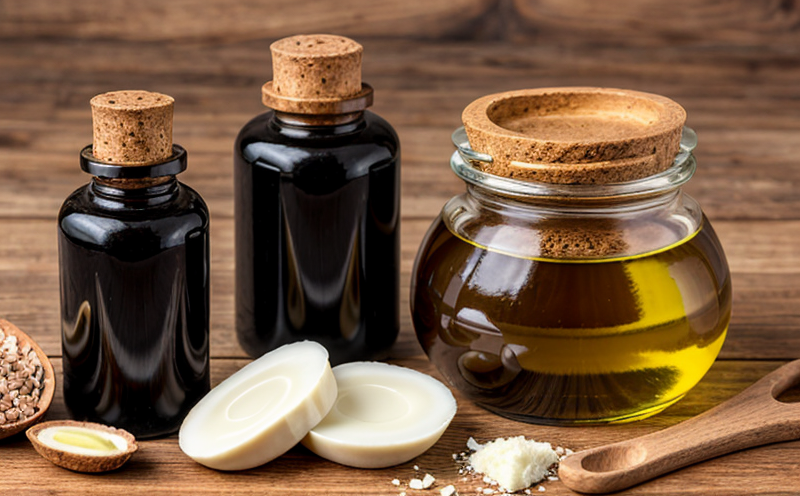ASTM D5556 Saponification Value in Fats
The saponification value is a critical parameter used to determine the amount of free and esterified fatty acids present in fats and oils. This test, conducted according to ASTM D5556, provides valuable insights into the purity and quality of these products, which are essential components across various industries such as food manufacturing, pharmaceuticals, and cosmetics.
During this process, a known mass of fat or oil is treated with an alcoholic solution of sodium hydroxide. The resulting reaction breaks down triglycerides into their constituent parts: glycerol and three fatty acids. After the neutralization reaction has taken place, the excess alkali required to reach complete saponification is titrated against a standard acid solution using phenolphthalein as an indicator. The volume of acid used in this titration directly corresponds to the amount of free or esterified fatty acids present.
The saponification value is calculated by dividing the mass of alkali consumed (expressed in grams) by the equivalent weight of potassium hydroxide, which is 56.1. This calculation yields a dimensionless number that quantifies the degree of unsaturation within the fat or oil sample. Higher values indicate greater levels of unsaturated fatty acids.
This method plays a pivotal role in ensuring product consistency and compliance with industry standards. For instance, in food manufacturing, it helps maintain consistent flavor profiles by controlling the level of free fatty acids that can affect taste and texture. In pharmaceutical applications, accurate measurement ensures that products meet stringent purity requirements necessary for safety and efficacy.
In addition to its direct application within specific sectors like food processing or biofuel production, understanding saponification value also supports broader research efforts aimed at developing more sustainable extraction methods or improving existing refining processes. By providing precise quantifications of fatty acid content, ASTM D5556 enables advancements in areas ranging from lipid chemistry studies to the design of novel cosmetic formulations.
Understanding how different factors influence results is crucial for interpreting outcomes correctly. Factors such as sample purity, temperature during titration, and choice of indicator can all impact final readings. Therefore, adherence to standardized procedures outlined by ASTM ensures reliable data across laboratories worldwide.
Scope and Methodology
The scope of ASTM D5556 encompasses the determination of saponification value for fats and oils based on their reaction with potassium hydroxide in an alcoholic medium. The procedure involves several key steps:
- Accurately weighing a specified quantity of fat or oil into a suitable container.
- Adding sufficient ethanol to dissolve all solids completely.
- Saturating the solution with sodium hydroxide until no further reaction occurs.
- Titrating any remaining alkali with standardized sulfuric acid while monitoring the endpoint visually using phenolphthalein indicator.
The saponification value is then calculated mathematically from these measurements. Compliance with this standard guarantees consistent results regardless of laboratory location or equipment used, fostering trust among stakeholders involved in procurement decisions and regulatory compliance.
Customer Impact and Satisfaction
Implementing ASTM D5556 contributes significantly to enhancing customer satisfaction by delivering accurate measurements critical for maintaining product quality standards. Quality managers rely on this service to ensure that suppliers meet specified criteria regarding fat content, which impacts both taste and nutritional value of final products.
Compliance officers benefit from knowing they can trust the data provided during audits or inspections because it adheres strictly to internationally recognized guidelines. R&D engineers appreciate having reliable information about raw materials since this knowledge allows them to optimize formulations continuously without compromising safety or effectiveness.
For procurement teams, consistent saponification values mean reduced risk associated with variability in supply chains. They can make informed choices based on standardized metrics rather than subjective evaluations alone. Ultimately, satisfied customers translate into stronger brand loyalty and long-term partnerships within the food & feed industry.
Frequently Asked Questions
Competitive Advantage and Market Impact
Ensures consistent quality across batches, thereby enhancing brand reputation.
Compliance with international standards builds trust among customers seeking reliable products.
Precise measurement facilitates better decision-making for procurement teams involved in selecting optimal suppliers.
Supports continuous improvement initiatives within R&D departments striving to optimize formulations without compromising safety or effectiveness.
Through adherence to ASTM D5556, laboratories gain a competitive edge by consistently delivering high-quality analytical services that meet stringent industry standards. This not only attracts repeat business but also opens doors to new opportunities in expanding markets where precision and reliability are paramount.





